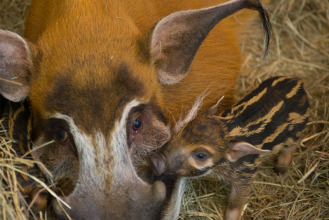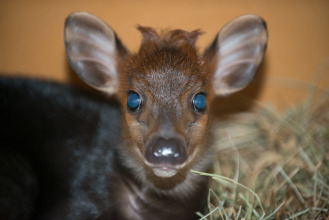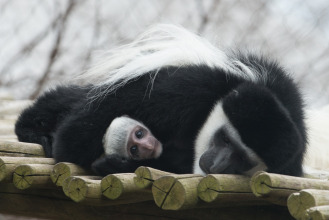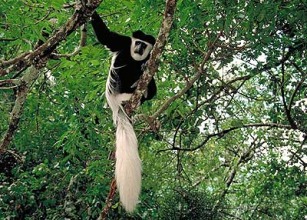Feed: Animal Fair
Posted on: Monday, April 29, 2013 18:21
Author: Animal Fair
Subject: It's A Baby Animal Boom At The Columbus Zoo!
Sheldon is a colobus monkey of the Columbus Zoo. The most recent new-born were 2 red river hog piglets came to this world on April 12th. They are currently with their mother, off exhibit. The red river hog is a wild member of the pig family in Africa, with most of its distribution in the Guinean and Congolese forests.
Two red river hog piglets were born this month! Earlier this month, on April 1st, the zoo welcomed a baby duiker. This is no April's Fool, the duiker is a real, forest-dwelling, animal, of the antelope family, which is found in the southern parts of Sierra Leone, Liberia, Ghana, Benin, and Nigeria. They are only 17 black duikers in American zoos, so this birth is very important! ________________________________________ Important to read: Just for Drivers, Voice-to-Text Is Likewise Harmful ________________________________________
The black duiker is a forrest-dwelling antelope However exiting news, these births' thunder was stolen by a male colobus monkey, named "Dr. Sheldon Cooper", after the quirky character of CBS's hit show, The Big Bang Theory. Colobus monkeys are born completely white and typically have their full adult coloration of black and white at the age of six months. Sheldon was born on March 3rd, and a little over a month, his coloring had already begun to change. Baby Sheldon is with his mother, off exhibit, until he is old enough to live with the grown-ups!
Little Sheldon snuggling with mom! The Columbus Zoo and Aquarium is a non-profit zoo with a worldwide reputation. It was, for instance, named by the USA Travel Guide as the number one zoo in the United States in 2009 and ranked number one best zoo in 2012 by Besties Readers Choice. Apart from that, the zoo is also deeply involved in animal and nature conservation and has distributed $4 million in conservation support since 2004. The colobus monkey: Colobus monkeys are diurnal primates and the most arboreal of all African monkeys. They live in all types of closed forests. Bamboo stands are also popular dwelling spots for the colobus. They occasionally come to the ground near streams to eat but prefer to remain higher in the canopy. Colobus monkeys are primarily folivorivous, although they also feed on stems, bark, flowers, buds, shoots, fruits, some aquatic plants' fruits and insects. They typically live in relatively small social groups of one adult male and normally two to six females with offspring. Young males in the group are forced to leave before they reach breeding age but may also challenge the dominant male for control of the females.
Funny fact: colobus monkeys don't have thumbs! The word "colobus" comes from the Greek "kolobós" ("docked"), and is so named because in these monkeys' thumbs are a stump. The IUCN does not believe there is sufficient information to determine the overall status of the black and white colobus monkey. They do believe it is facing a high risk of extinction in parts of its range. The biggest threat to the black and white colobus monkey is the destruction of forests and other habitats. It is also hunted for meat and for their fur. In protected parts of its range, black and white colobus monkeys is quite common. However, in other parts of the world, numbers have declined dramatically. |
FACEBOOK COMMENT by JETZTKAUFEN.INFO - best online store




